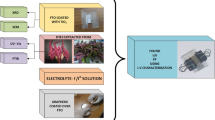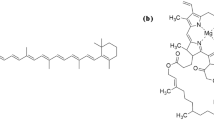Abstract
Dye-sensitized solar cells (DSSC) were fabricated with dyes extracted from the leaves of Amaranthus red and Lawsonia inermis (Henna). A total of ten dyes were synthesized using solvents like distilled water, acetone and ethanol. UV–Vis spectroscopy was taken for all the dyes prepared. FTIR was taken for the dyes which had maximum absorption in the visible region. FTO substrates coated with nanosized TiO2 sensitized with dyes extracted were the photoanodes. Counter cathode was primed using graphene-coated FTO films. Two solar cells have been made up with the efficient dyes prepared from Amaranthus and Henna. J–V characterization performed for the cells showed that the solar cell fabricated with Amaranthus dye was efficient with the photoconversion efficiency and fill factor of 0.14% and 0.3864, respectively, compared to the cells fabricated using Henna dye whose photoconversion efficiency and fill factor are 0.09% and 0.3851, respectively.










Similar content being viewed by others
References
B. O'Regan, M. Gratzel, Nature 353, 737 (1991)
H.P. Kuo, C.T. Wu, Sol. Energ. Mat. Sol. C. 120, 81 (2014)
N.A. Karim, U. Mehmood, H.F. Zahid, T. Asif, Sol. Energ. 185, 165 (2019)
G. Richhariya, A. Kumar, P. Tekasakul, B. Gupta, Renew. Sust. Energ. Rev. 69, 705 (2017)
S. Wu, S. Yuan, L. Shi, Y. Zhao, J. Fang, J Colloid Interf. Sci. 346, 12 (2010)
N.A. Ludin, A.M.-A. Alwani Mahmoud, A.B. Mohamad, A.A.H. Kadhum, K. Sopian, N.S.A. Karim, Renew. Sust. Energ. Rev. 31, 386 (2014)
M.K. Nazeeruddin, P. Pechy, M. Gratzel, Chem. Commun. 18, 1705 (1997)
N.G. Park, J. Lagemaat, A.J. Frank, J. Phys. Chem. B. 104, 8989 (2000)
J. Wu, Z. Lan, S. Hao, P. Li, J. Li, M. Huang, Pure Appl. Chem. 80, 2241 (2008)
R.S. Shelke, S.B. Thombre, S.R. Patrikar, Int. J. Res. Sci. Adv. Tech. 3, 131 (2013)
M. Gratzel, J. Photochem. Photobio. C. 4, 145 (2003)
G. Wu, V. Shen, F. Gu, H. Lu, Y. Xie, J. Zhang, ACP (2009). https://doi.org/10.1364/ACP.2009.WL43
W.J. Lee, E. Ramasamy, D.Y. Lee, J.S. Song, Sol. Energ. Mat. Sol. C. 91, 1676 (2007)
P. Selvaraj, H. Baig, T.K. Mallick, J. Siviter, A. Montecucco, W. Li, M. Paul, T. Sweet, M. Gao, A.R. Knox, S. Sundaram, Sol. Energ. Mat. Sol. C. 175, 29 (2018)
R. Ramanarayanan, P. Nijisha, C.V. Niveditha, S. Sindhu, Mater. Res. Bull. 90, 156 (2017)
https://www.hennacolorlab.com/what-is-henna/ Accessed 01 Sept 2019
S.S. Kulkarni, S.S. Hussaini, G.A. Bodkhe, M.D. Shirsat, Surf. Rev. Lett. (2019). https://doi.org/10.1142/S0218625X18501640
H. Zhou, L. Wu, Y. Gao, T. Ma, J. Photochem Photobio. A. 219, 188 (2011)
N.A. Ludin, A.M.-A.L. Alwani Mahmoud, A.B. Mohamad, A.A.H. Kadhum, K. Sopian, N.S.A. Karim, Renew. Sust. Energ. Rev. 31, 386 (2014)
S. Ananth, P. Vivek, T. Arumanayagam, P. Murugakoothan, Spectrochim. Acta A. 128, 420 (2014)
J. Uddin, J.M.M. Islam, E. Karim, S.M.M. Khan, S. Akhte, E. Hoque, M.A. Khan, Int. J. Thin Films Sci. Tech. 4(2), 141 (2015)
Acknowledgements
This work was funded by DST Government of India (EMR/2016/007874). Sowmya S, Pooja Prakash and Ruba N) wish to acknowledge Karpagam Academy of Higher Education for providing KAHE Research Fellowship to carry out this research work. Sowmya S would like to acknowledge Mr. P. Vivek, Research Scholar, Sri Ramakrishna Mission Vidyalaya College of Arts and Science, Coimbatore and Dr. P. Balraj, Assistant Professor, Coimbatore Institute of Technology, Coimbatore for their timely help and support.
Author information
Authors and Affiliations
Corresponding author
Ethics declarations
Conflict of interest
There is no potential conflict of interest among the authors.
Additional information
Publisher's Note
Springer Nature remains neutral with regard to jurisdictional claims in published maps and institutional affiliations.
Rights and permissions
About this article
Cite this article
Sowmya, S., Pooja Prakash, Ruba, N. et al. A study on the fabrication and characterization of dye-sensitized solar cells with Amaranthus red and Lawsonia inermis as sensitizers with maximum absorption of visible light. J Mater Sci: Mater Electron 31, 6027–6035 (2020). https://doi.org/10.1007/s10854-020-03154-8
Received:
Accepted:
Published:
Issue Date:
DOI: https://doi.org/10.1007/s10854-020-03154-8




